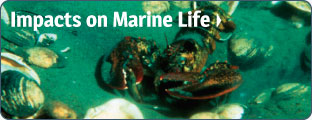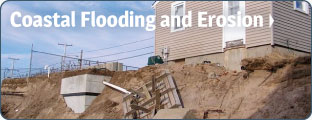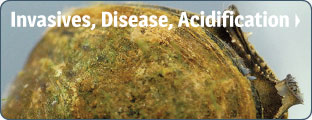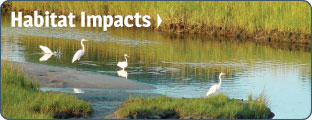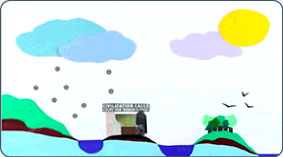
Photo Credit: Rhode Island Sea Grant
Beneath the Waves
Rhode Island’s coasts are the life-blood of the state. Fish swimming in the coastal waters off Point Judith, oysters thriving in aquaculture bags in the salt ponds, and healthy salt marshes that provide habitat for birds all contribute to the bounty and beauty of The Ocean State.
Climate change will impact the coasts of Rhode Island in a variety of ways. But, it goes beyond that. Our oceans and coasts are strongly linked with and influenced by the oceans and coastal areas of our neighboring states. So changes that happen next door will cross over into our waters. Nature doesn’t recognize geographical boundaries, socioeconomics or politics.
Do you enjoy fishing for striped bass with your family and friends? If you want the striped bass to be healthy when you are ready to catch and eat them in the spring and summer, then you also should be concerned about whether climate change is impacting them in the winter when they are hanging out in the Chesapeake Bay and North Carolina — the state where the use of the term climate change is banned. This is just one example of why we all need to put aside our biases and work together.
The good news is that we know we need to do something to prevent these impacts from being catastrophic. We have residents, volunteers, and scientists already figuring out what we need to do to help. Now, we need to listen to what the experts are telling us and put their recommendations into play before our coasts — and we — pay the price.
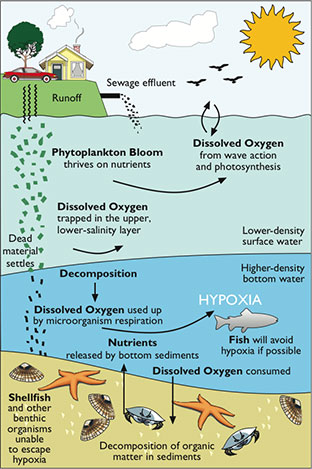
Climate change is predicted to cause more intense storm events, which can have cascading effects in our coastal areas as Rhode Islanders saw with the 2003 Greenwich Bay fish kill.
Click to enlarge
National Coastal Condition Report IV, EPA-B42-R-10-003 (April 2012)
Collateral Damage Found to be Fishy
Most of you probably remember the 2003 fish kill in Greenwich Bay. Summer was drawing to a close at the end of August, we had several large rainstorms just a few weeks prior, and many beaches were closed across the state. And then over a million dead fish washed ashore. What happened?
The most basic answer is that the fish suffocated because there was not enough oxygen in the water. (This is called anoxia if there is no oxygen and hypoxia if there is low oxygen.) But why was there a lack of oxygen? That is where it gets more complicated and, as you have probably caught on to by now, few questions in nature have a simple and straightforward answer.
Let’s go back to those heavier-than-normal rainstorms in early August 2003. All of that extra precipitation eventually makes its way to the Bay and takes with it a flood of extra nutrients — and again, nutrients aren’t necessarily a good thing in this scenario. Tiny plants in the water called phytoplankton gorge themselves on this extra food and become overly abundant. These tiny guys have a short lifespan though and they soon die. Then decompose. And when decomposition occurs it uses oxygen from the water. So, a lot of tiny dead plants = a lot of decomposition = oxygen being used up in the water. And suddenly, animals that need that oxygen to live have a problem.
Hypoxic (low oxygen) conditions occur fairly regularly and you probably don’t even realize it. Some animals that can’t move can survive brief amounts of time with low oxygen. Other animals that can swim away simply leave the area and then come back when oxygen levels go back up. But when the event is extreme — like it was in August 2013 — there is no time to move and then fish, crabs, oysters, and other animals die.
Rhode Island is expected to experience more severe precipitation events due to climate change. That means that we may see severe hypoxic events more often in the future. How long do you think our coasts can remain healthy and productive if one million fish are washing ashore every year or two? How many beach goers will want to come back if they associate Rhode Island with dead, smelly fish?
“All drains lead to the ocean, kid.”
– Gill, Finding Nemo
News
“Tourists Are Flocking to Locations Threatened by Climate Change. That Only Makes Things Worse.” Vox
Factoids
Changes in coastal habitats that affect numerous fish species are likely to impact the future of saltwater recreational fishing, an industry worth approximately $19.5 billion per year.
Over 50% of commercially harvested fish in the U.S. depend on estuaries and coastal waters during some stage of their life cycle. As climate change impacts these critical habitats valuable commercial fishing species may experience interruptions in their reproduction and growth cycles.
Climate change is likely to worsen many issues already facing coastal areas including shoreline erosion, coastal flooding, water pollution due to human impacts, and loss of coastal wetlands to rising sea levels and encroaching development.
 Tell Us What You Think
Tell Us What You Think
 Additional Resources
Additional Resources
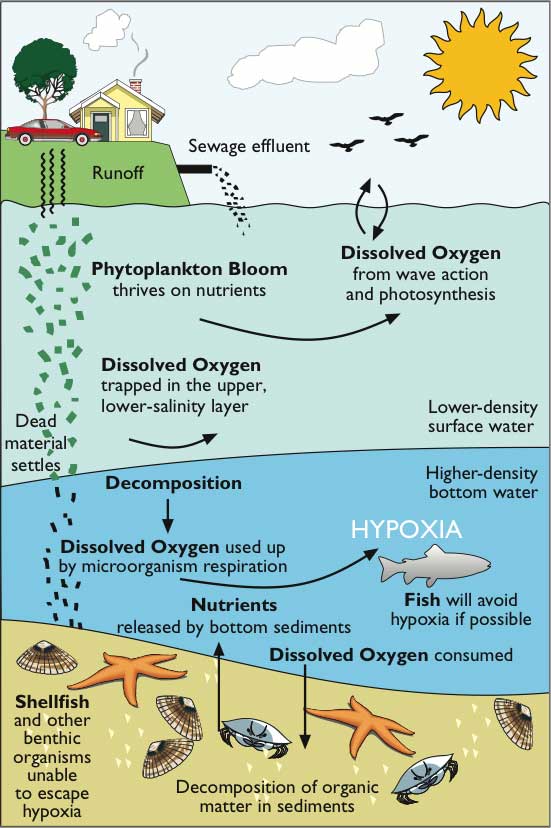
Source: National Coastal Condition Report IV, EPA-B42-R-10-003 (April 2012)
